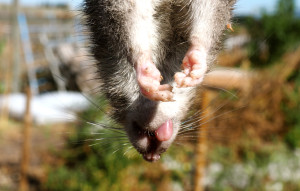These are some common reccommendations we make to farmers to mitigate their rat issues
Isolate feed
Only scatter as much feed or grain or compost as chickens (or other livestock) can eat by 1pm
Hanging feeders can be set over a large bowl or tray to catch scattered feed. This tray and feeder should be picked up and put away in a sealed container at night.
Feed in a large wide, high rimmed conainer such that birds can get in but feed doesn’t scatter.
We like treadle feeders for small operations such as these
Oat hay and other grain hay should be stored in a sealed shed
Small scale hay should be stored 18″ off the ground on raised pallets.
Call in the Mongrol Hoard when the hay is low between loads.
Use an alternative hay such as alfalfa or timothy grass.
In situations where rats are feeding on fruit trees or garden plants it is essential to find and disrupt nests.
Structures
Leave chicken runs/coop with a dirt floor so our dogs can dig.
Optionally, enclosed coops should be raised 18″ off the ground on posts or blocks so our dogs can go under.
Do not place chicken wire or hardware cloth under floor boards as this creates ideal nesting areas for rats (we see this all the time)
Do not line floors of coops with chicken wire or hardware cloth as this creates a roof for rats and makes it more difficult for us to dig for them.
Build coops in open areas without hiding places for rats (see minimize habitat below).
Minimize Habitat
Rats will predictably bunker down close to their feed source in places where there is a solid roof or protection for their burrow entrances. These include stands of bamboo, blackberries, pampas grass and ivy as well as wood piles and stone walls. By clearing these protective islands (or building your coop away from such things to begin with) you can limit the number good nesting places for rats. If your barn or coop has doubled walls, making an easy way to open these to flush out rats is a good idea. Unfortunately rats will also burrow under concrete foundations, patios and barn floors. These should be flushed out with water at first sign of fresh burrowing.
Trapping
Trapping can be effective but only if done properly. Rats are smart and will learn quickly to avoid them.
Set traps along walls and edges where rats run.
For best results with snap traps, place them with bait for several days without setting them. Use a bit of peanut butter to hold corn or other grain in place. Check traps daily to see if rats have been eating the bait. After 4 days leave in place without bait for one night. Then bait and set.
If there is concern for other small animals setting off the traps (such as cats) the traps can be set into a small cardboard box. Cut a rat sized hole in either side so the rats run through to get the bait (a rat is less likely to enter a one sided hole.
Bait
We recommend Rat X as a non toxic bait. It is made of corn soaked in salt solution. The rats eat it and get thirsty but cannot drink. They die of thirst and dessication. Not pretty, but also not toxic to the food chain or anything else that might happen upon the bait.
Other deterrents (things rats hate)
Holes in walls or places rats run can be stuffed with mothballs which rats hate. Chili powder can be sprinkled around or mixed in with chicken feed (chickens can’t taste it but rats hate it). Rats also dislike mint oil which can be bought in bulk and sprayed in places they run.

